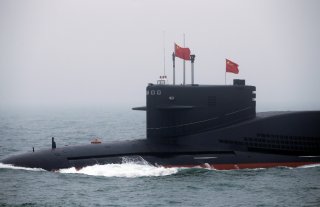Ratifying UNCLOS Can Counter China's Growing Naval Strength
Washington must reassert formidable leadership by upholding the example it sets forth on multilateral platforms.
China began its rapid naval expansion in the mid-1980s, initially prioritizing the immediate vicinities of East Asia and the Taiwan Strait. Today, its power projection capabilities have expanded beyond those of a regional force—it seeks hegemony in the high seas.
Beijing expanded its aspirations in the Indian Ocean in 2008, taking a larger role in responding to the piracy crisis in the Gulf of Aden to protect its overseas economic investments. The People’s Liberation Army Navy has made additional deployments ever since, and the first overseas Chinese military base was established in Djibouti in 2017.
While Washington maintains a labyrinth of bilateral and multilateral partnerships and alliances, Beijing is also stepping up its diplomatic engagement through a whole-of-government approach. Central to the United States’ strategy to counter China’s unilateral activities is the Quadrilateral Security Dialogue, or Quad, a core grouping of Australia, India, Japan, and the United States as a tacit check on Chinese revisionism.
All four Quad members have championed a vision for a Free and Open Indo-Pacific to ensure free and unfettered access across all five (land, air, sea, space, and cyber) domains. However, only three members of the Quad have ratified the United Nations Convention on the Law of the Sea (UNCLOS).
UNCLOS is a 1982 international agreement that establishes international legal standards for maritime activities. The agreement, which has been ratified by 166 countries, is the most critical legal instrument for governing the use of the high seas. Among other things, it delineates the twelve-mile limit on a nation’s territorial waters and the two hundred-mile exclusive economic zone (EEZ).
China pursues a blue water navy capable of projecting power beyond its two hundred-mile EEZ. This force will be capable of engaging in a display of gunboat diplomacy through offensive means, such as strike and interdiction.
Meanwhile, China has also developed artificial military islands within the first island chain out of reefs and atolls. Some of these islands now host airstrips and hangars to accommodate combat aircraft.
Beijing is building a "modern navy with Chinese characteristics.” It set forth broad objectives to reach an “informationized” and “mechanized” force by 2027 in its fourteenth Five-Year Plan.
By informatization, Chinese policymakers refer to improving jointness to enhance decision-making capabilities for its critical Command, Control, Communications, Computers Intelligence, Surveillance, and Reconnaissance (C4ISR) networks and to mitigate stovepipe challenges. With mechanized components, Beijing is integrating industrial technologies to advance its warfighting capabilities. Its interest in these capabilities was fueled by the United States’ demonstrated technological superiority during the First Gulf War.
In lieu of adhering to a traditional alliance framework, Beijing has emphasized a non-aligned posture since 1982. Chinese policymakers have also adopted a hierarchical strategic partnership policy. Chinese partnerships range from (in descending order) comprehensive strategic partnerships, strategic partnerships, friendly partnerships, and partnerships.
Meanwhile, the multi-trillion-dollar Belt and Road Initiative (BRI) permits China to receive exclusive access to dual-use ports. This allows its naval footprint to extend beyond the first island chain. China is dominating global critical infrastructure by, among other things, seeking control over the world’s largest ports. It is already involved in forty-two ports in thirty-four countries. It currently manages these ports, signifying that in the event of hostilities, it will maintain strategic access to support major force and material deployments. Such infrastructure development projects enable China's leadership to address the country’s labor needs as it employs many of its citizens in state-owned enterprises.
As the recent United States withdrawal from Afghanistan leaves partners and allies questioning American resolve, Washington must reassert formidable leadership by upholding the example it sets forth on multilateral platforms. Ratifying UNCLOS would be an excellent step forward.
The United States’ initial argument against joining the convention was that it would violate its sovereignty. However, Washington has indirectly supported the principles of UNCLOS.
In 1983, President Ronald Reagan accepted most of the convention’s stipulations. More recently, the United States supported the Permanent Court of Arbitration’s ruling in favor of the Philippines in 2013. It is the Senate that has blocked its ratification on numerous occasions.
At the very least, the United States should consider joining UNCLOS as a diplomatic coalition to prey on China’s self-isolation as regional partners and allies continue to be harassed by Beijing’s attempts to change the status quo. It’s time for Washington’s policy to change.
Saba Sattar is a doctoral candidate of Statecraft and National Security at the Institute of World Politics in Washington D.C. She specializes in security challenges in the Indo-Pacific region across the conflict continuum, from addressing the totalitarian Islamist phenomenon to Chinese geoeconomic ambitions. She holds an M.A. in Statecraft and National Security Affairs, along with a B.A. in International Affairs and B.S. in Criminology from George Mason University.
Image: Reuters.

